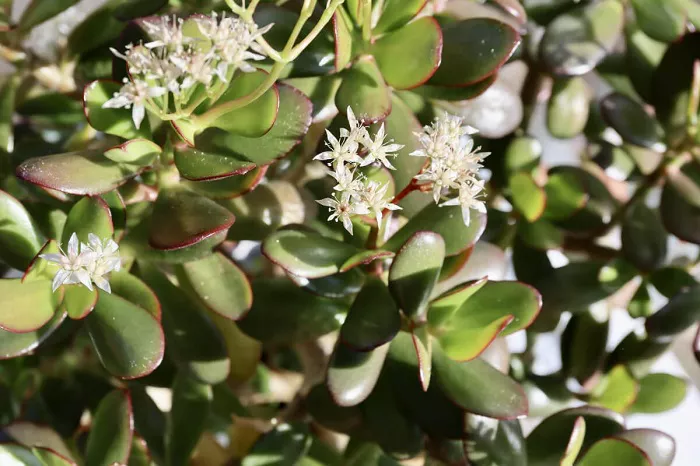Jade plants are beloved for their lush, succulent leaves and ease of care. However, many growers eagerly await the sight of their jade plant blossoming. Achieving flowers on a jade plant can be a rewarding experience, but it requires understanding the plant’s needs and providing the right conditions. In this article, we will explore the factors that influence jade plant flowering and provide practical tips to help your plant reach its full blooming potential.
Understanding the Nature of Jade Plants
Jade plants, scientifically known as Crassula ovata, are native to South Africa. They thrive in warm, arid climates and are well-adapted to drought conditions. While jade plants are primarily grown for their attractive foliage, they can produce beautiful star-shaped flowers under the right conditions. These flowers are typically white or pale pink and often appear in clusters, adding a touch of elegance to the plant’s appearance.
The Role of Light in Flowering
Light is a crucial factor for jade plant flowering. In their natural habitat, jade plants receive plenty of sunlight. To encourage flowering, place your jade plant in a location where it can receive at least six hours of direct sunlight per day. A south-facing window is ideal, but if natural light is insufficient, you can supplement it with grow lights. Ensure the light source is bright but not too intense to avoid scorching the leaves.
The Importance of Temperature
Temperature also plays a significant role in promoting flowering. Jade plants prefer a warm environment during the day, with temperatures around 70°F (21°C). However, they need a cooler period at night, ideally between 50°F and 55°F (10°C to 13°C). This temperature variation mimics their natural habitat and helps trigger the flowering process. If your home is consistently warm, consider moving the plant to a cooler room at night or using a small fan to create a slight temperature drop.
Watering and Soil Requirements
Proper watering and soil conditions are essential for healthy growth and flowering. Jade plants are succulents and store water in their leaves and stems. Overwatering can lead to root rot and prevent flowering. Allow the soil to dry out completely between waterings, and then water thoroughly until water drains from the bottom of the pot. Using well-draining soil is crucial. A mix specifically designed for succulents or a blend of potting soil, perlite, and coarse sand works well. This ensures that excess water drains quickly, preventing waterlogged roots.
Fertilizing for Flower Buds
Nutrient-rich soil can support the development of flower buds. During the growing season, which is typically spring and summer, fertilize your jade plant every two months with a balanced, water-soluble fertilizer. Choose a fertilizer with equal parts nitrogen, phosphorus, and potassium (NPK), such as a 10-10-10 formula. Dilute the fertilizer to half strength to avoid over-fertilizing, which can cause excessive leaf growth at the expense of flowers. In the fall and winter, reduce fertilization to once every three months to allow the plant to rest.
Pruning for Better Flowering
Pruning can help shape your jade plant and promote flowering. Remove any dead or damaged leaves and stems to encourage healthy growth. You can also trim back overgrown branches to create a more compact and bushy plant. Pruning in late winter or early spring is ideal, as it allows the plant to recover and prepare for the growing season. Be sure to use clean, sharp tools to avoid damaging the plant.
Encouraging Dormancy
Many plants, including jade plants, require a period of dormancy to prepare for flowering. During dormancy, the plant’s growth slows, and it conserves energy for the upcoming blooming season. To encourage dormancy, reduce watering and fertilization in the fall. Place the plant in a cooler, darker location for a few weeks. This period of rest helps the plant reset and prepares it for the conditions that trigger flowering.
The Role of Humidity
While jade plants are adapted to arid environments, they can benefit from moderate humidity levels, especially during the flowering stage. If the air in your home is too dry, consider using a humidifier or placing a tray of water near the plant. However, avoid over-humidifying, as excessively moist conditions can lead to fungal growth and other issues.
Patience and Persistence
Encouraging a jade plant to flower can take time and patience. Some jade plants may take several years to reach maturity and produce flowers, especially if they are grown from cuttings. Continue to provide optimal care, and be patient. Over time, your efforts will likely be rewarded with beautiful blooms.
Conclusion
Getting your jade plant to flower is a rewarding journey that requires understanding its natural needs and providing the right conditions. By ensuring adequate light, proper temperature variations, well-draining soil, balanced fertilization, and a period of dormancy, you can encourage your jade plant to produce beautiful flowers. With patience and care, your jade plant can become a stunning centerpiece in your home.


